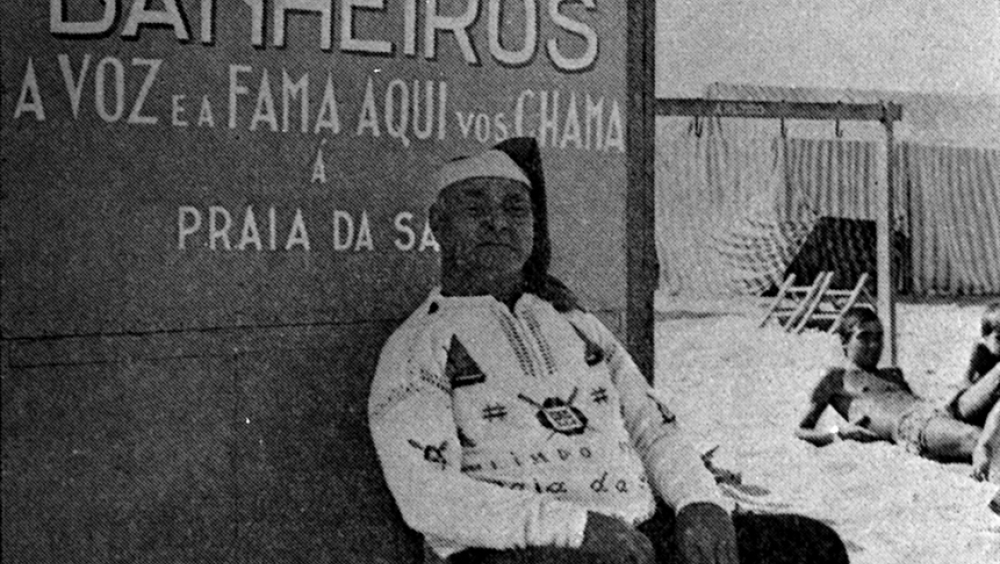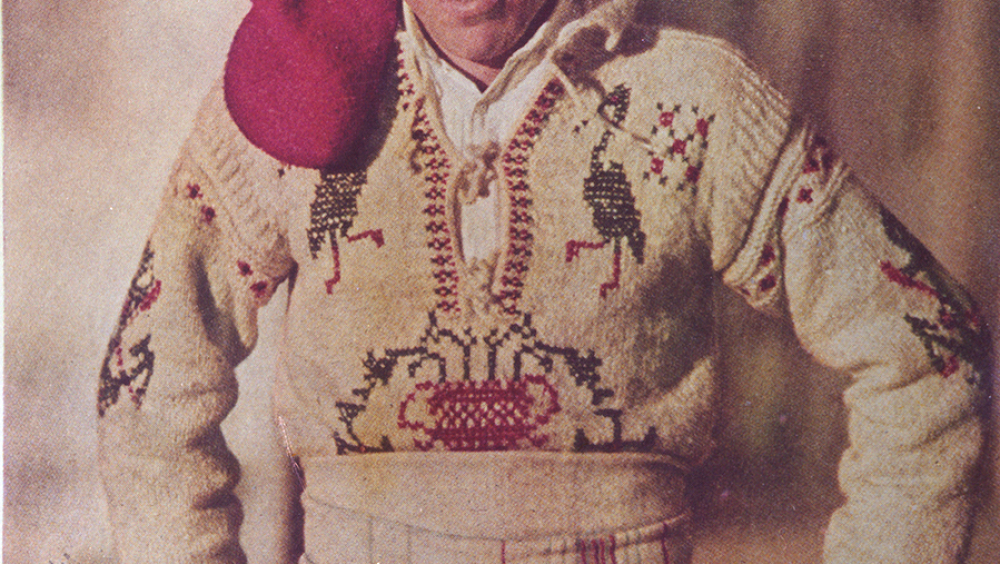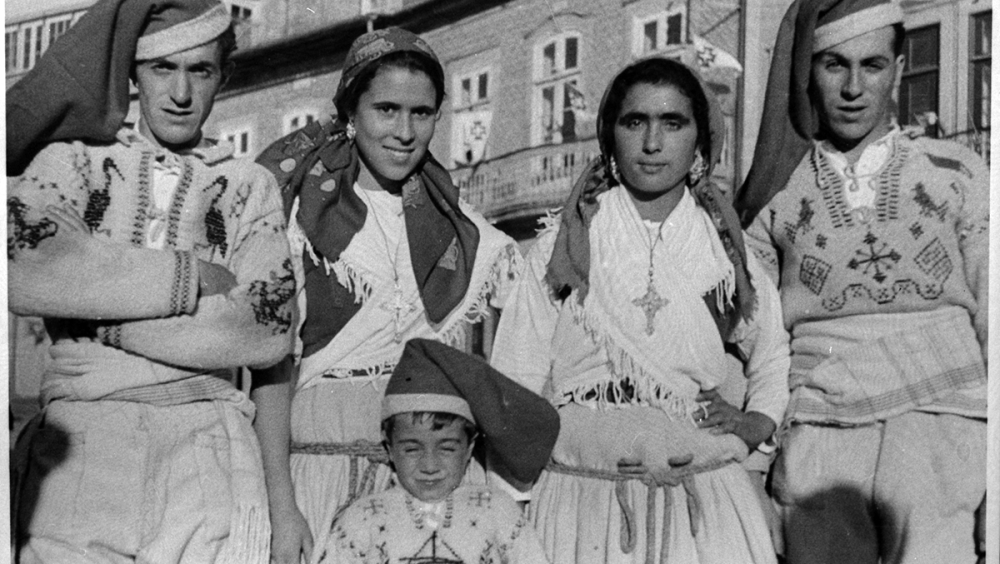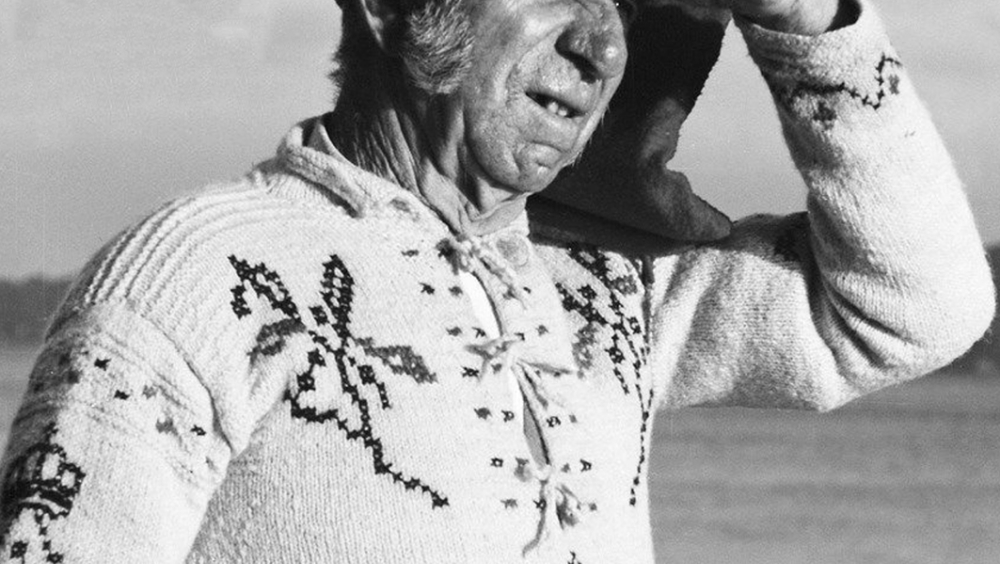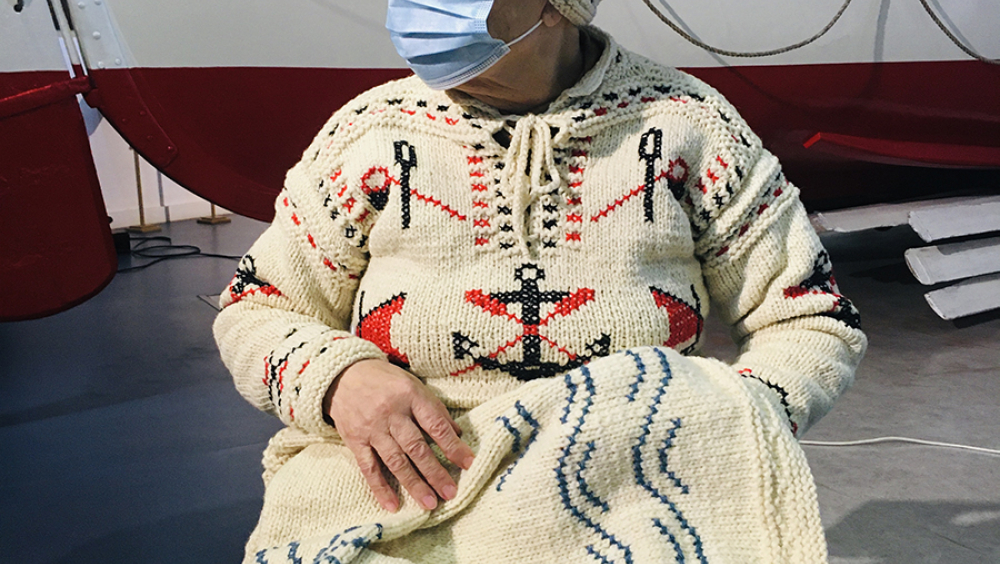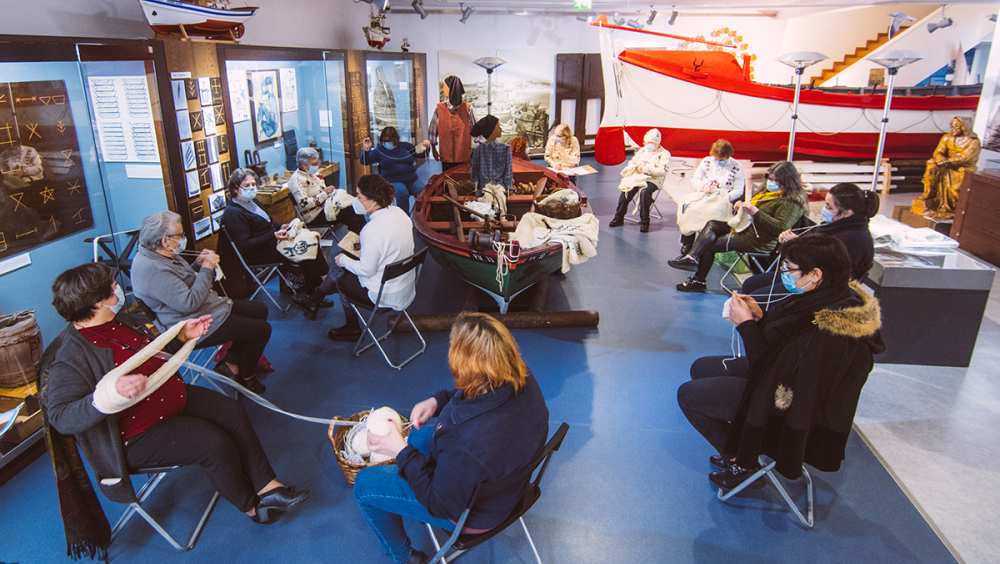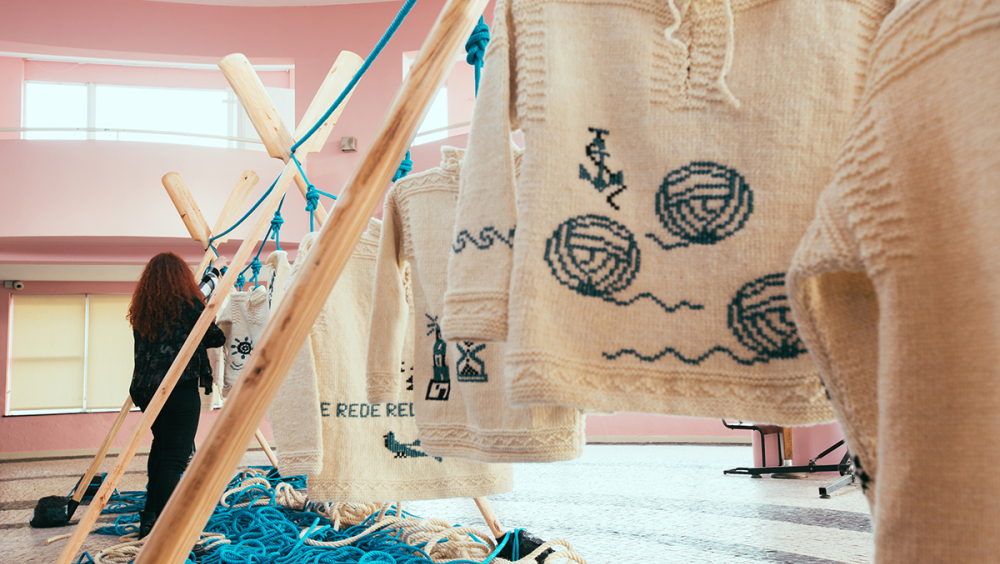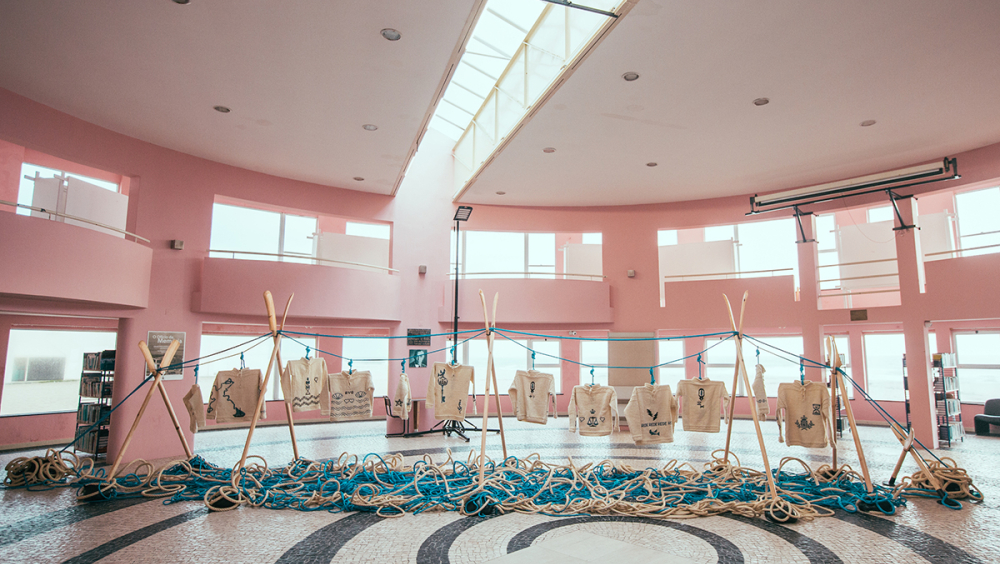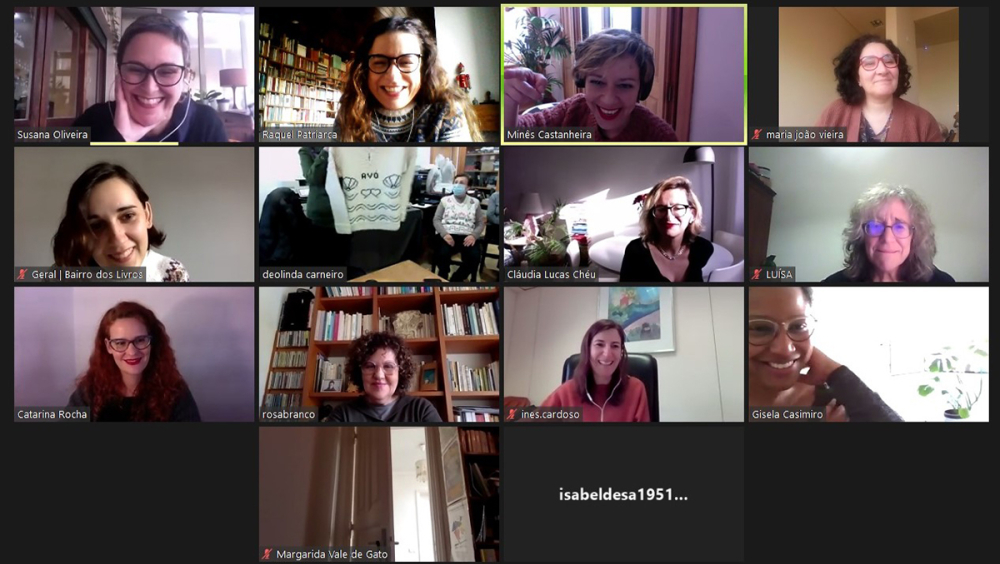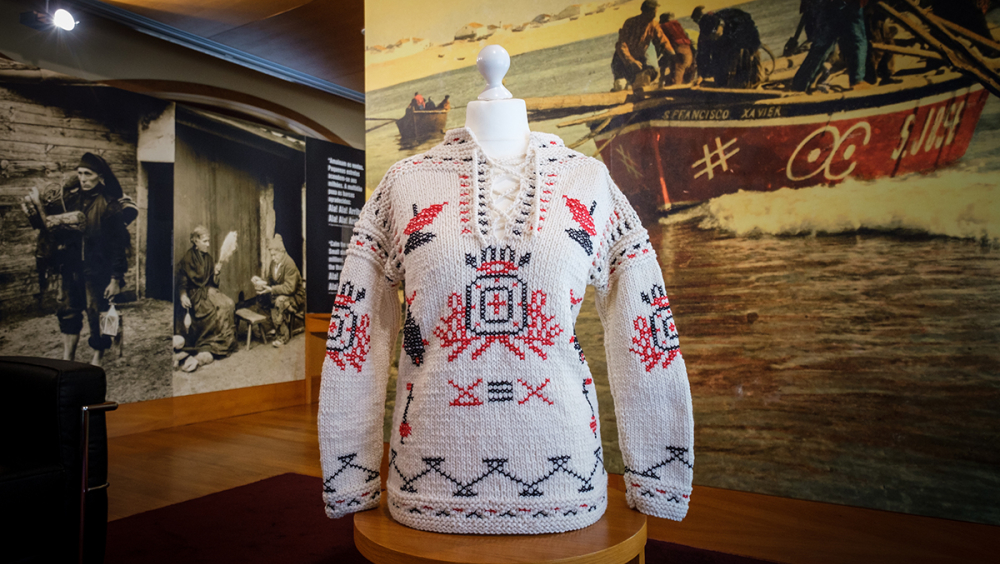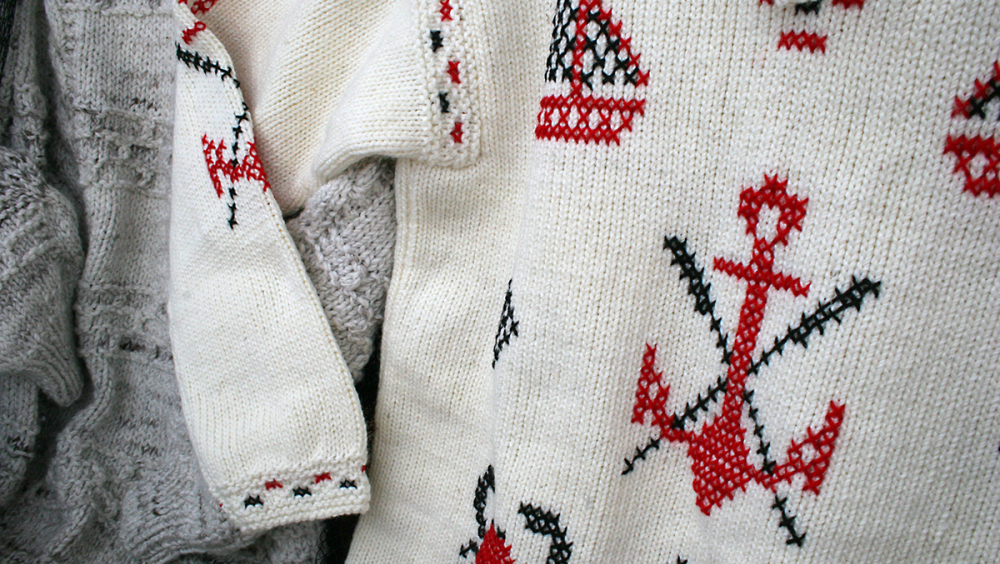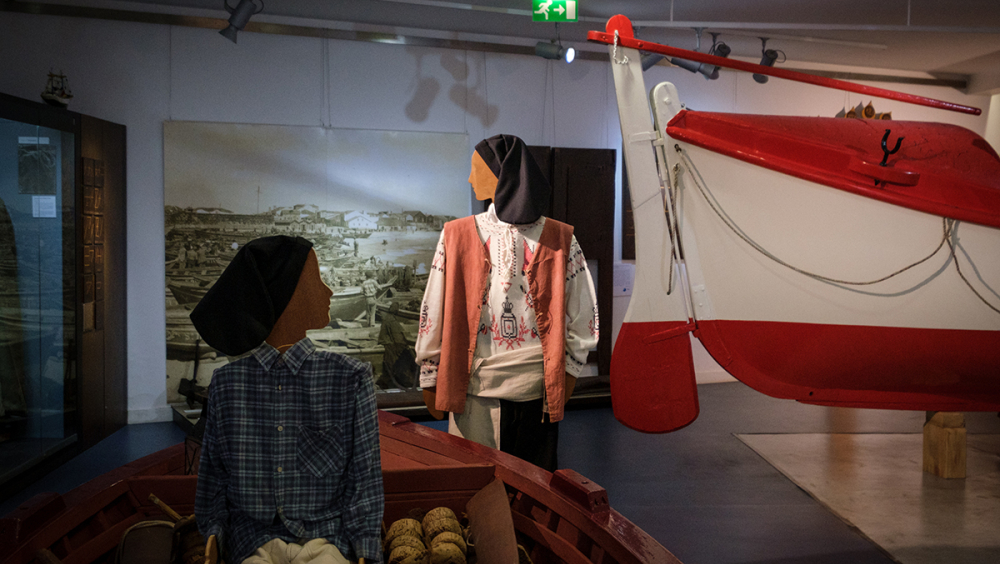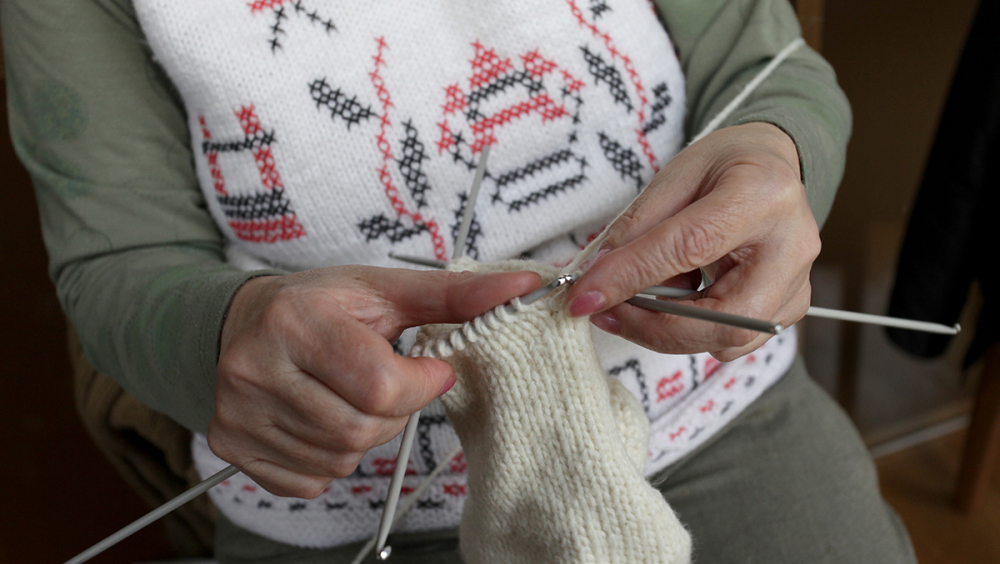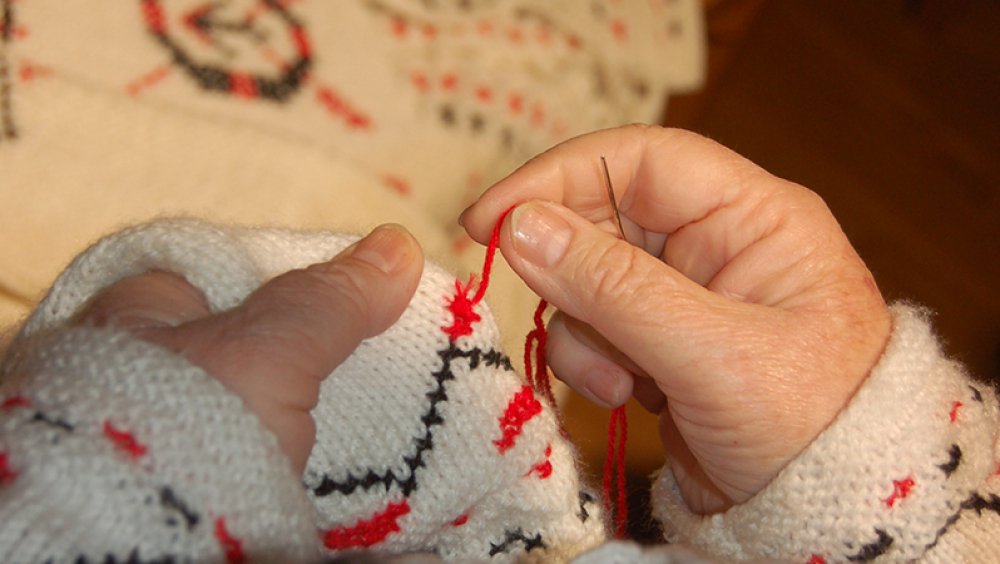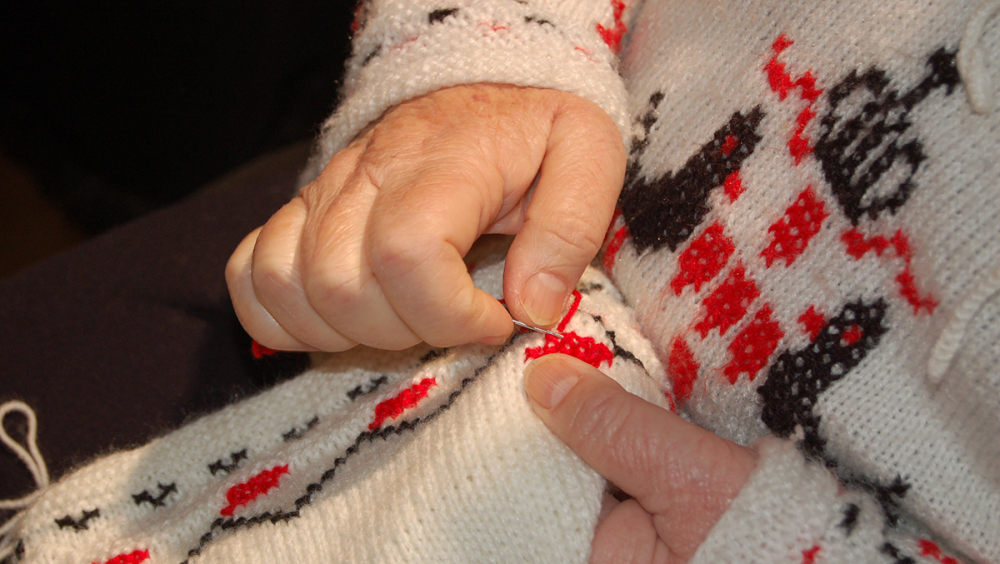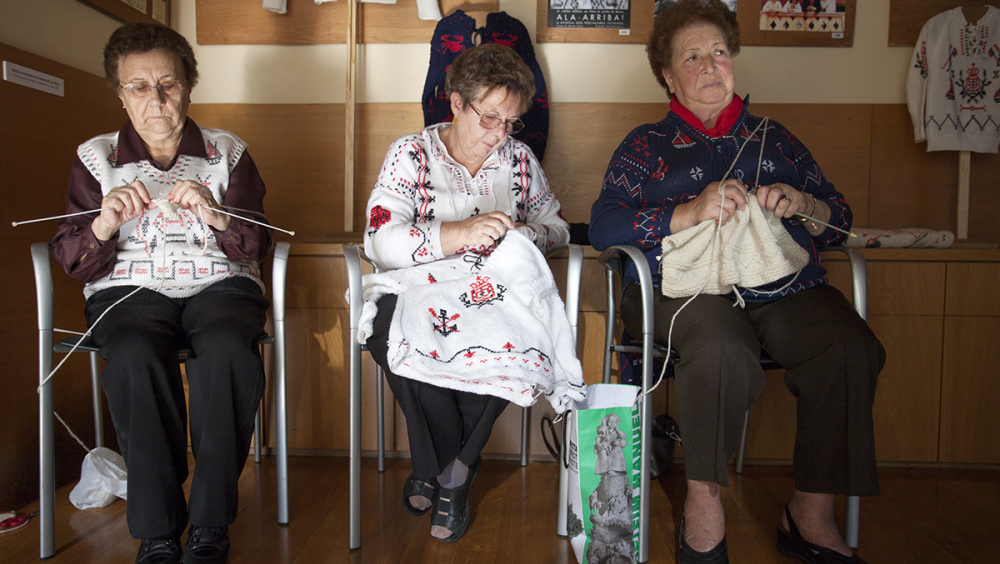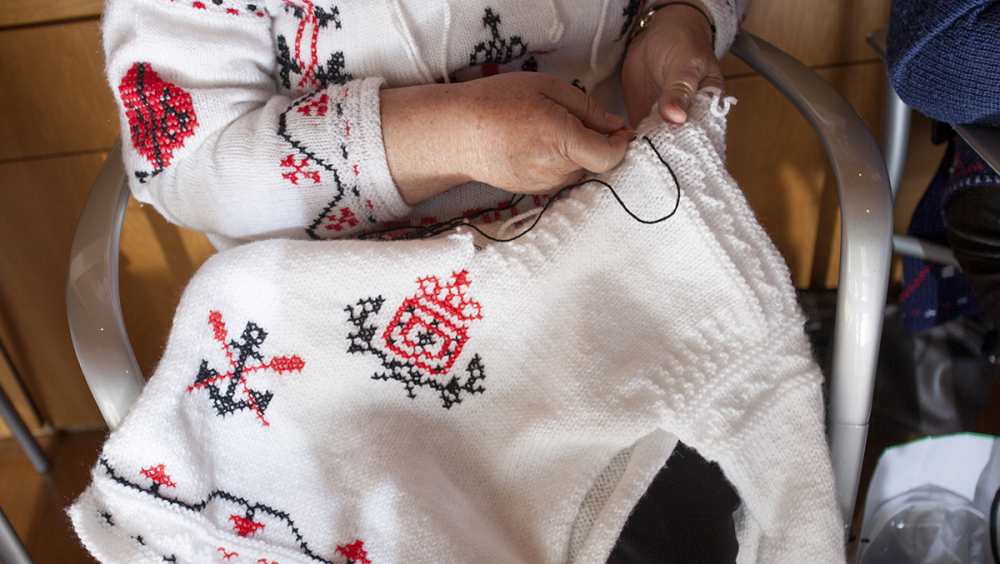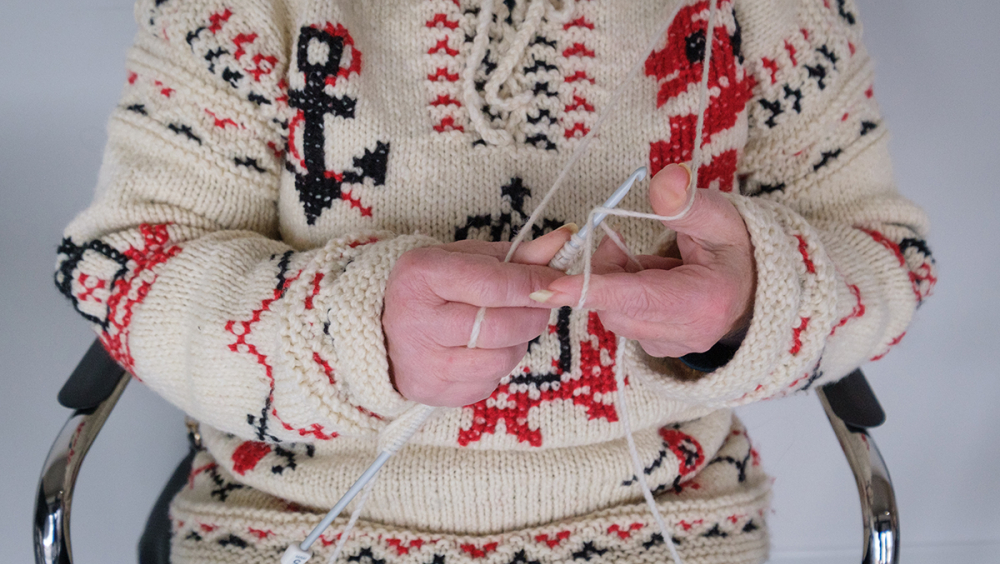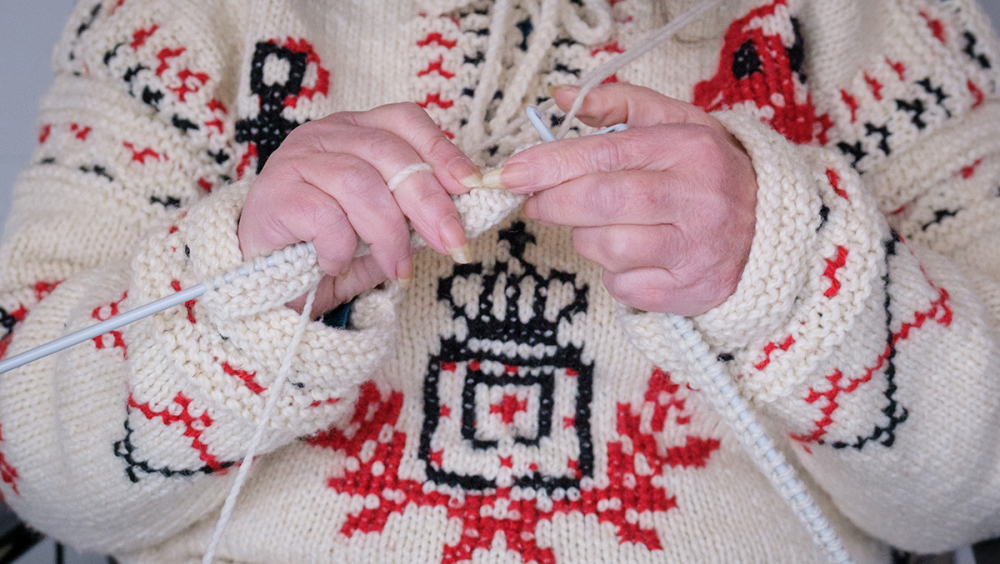The Penelopes & Camisola Poveira
This story reveal the European dimension of the local heritage. The Penelopes is an artistic approach to the iconic handy-knitted fisherman sweater camisola poveira made by women of Póvoa de Varzim (a northern seaside town of Portugal) in the last 150 years or more. The Penelopes brings together original literary texts, starting from the figure of Penelope and the heritage of the fishing community of Póvoa de Varzim, in order to pay homage to the Feminine. This collaborative artistic project developed in 2021 put in dialogue literature and the art of embroidery, exhibit in a contemporary installation created with the traditional camisola poveira. The embroidery used in the artistic installation combines traditional symbols of the typical pattern of Póvoa de Varzim with images taken from the original texts written for this project. The Penelopes carefully approach the cultural landscape and look back inside the house, at the many fishing nets thrown at the path, at the artifacts of wood spread out on the beach.
This project artistically explore aspects of a society whose organization and traditions are, above all, matriarchal. The primitive epic. Eve at the beginning of everything. Those sweaters had fallen into disuse in the fishing community at the end of the 19th century, as a result of the mourning instituted precisely after the great shipwreck. No longer the shroud of the greek Penelope for Laertes, but those sweaters as a result of the mourning instituted precisely after the great shipwreck, and recovered, in 1936, as costumes of the local folkloric group showing off their thick white wool sweaters, whimsically embroidered in colors with no fantasy limit in the drawings – flowers, fish, hearts, signs and everything else that might have a symbolic meaning. The camisolas poveiras, decorated by the brides, sisters or mothers of the local fishermen’s, are a place for coded dedications of affection, as well as a symbol of belonging to the community of Póvoa de Varzim.
This cultural artefact, defended by the ministry of culture of Portugal, is an ode to the spirit and historical heritage legacy of Póvoa de Varzim, as well as a way to value and dignify the work done by local artisans. Through workshops and exhibitions at the local museum, the community were encouraged to know more about their own cultural heritage and to develop skills related to the produce camisolas poveiras handmade sweaters according traditional methods. In schools, teachers and pupils have shared the tangible and intangible dimensions of this heritage. They enjoyed learning and exploring cultural heritage together.
Legend has it that Penelope waited twenty years for Ulysses to return from the War of Troy. In greek mythology she is one of the few hailed women, highly regarded for remaining faithful to her marriage vows, above all other virtues. Pressured to remarry and, thus, surrender the domain of the kingdom, Penelope resorted to a skillful plan: the choice of one of her many suitors could only happen after finishing a tunic that she wove along with her twelve servants and secretly undid. When he finally returned, Ulysses proved his identity, but not before testing Penelope's virtue, naturally. The gods then granted the lovers an endless night, so they could linger in each other's arms and Ulysses could narrate his many and troubled adventures.
From the lighthouse in Ithaca, we send mirror signals to illuminate Póvoa’s mythology. Santos Graça called it the “Epic of the Humble” and set the tragic-maritime history of the fishermen from Póvoa de Varzim, an image that even António Nobre sang and with whom he wanted to “be part of the sea”. In successive chants over time, this character was reemerged from oblivion. And even though the maritime tragedy of 1892 – characterized as a “dreadful catastrophe” by the periodical O Occidente – and the economic and social landscape of the region were portrayed by writers such as Ramalho Ortigão, Alberto de Oliveira or Ferreira de Castro, and by historians such as Cândido Landolt and José de Azevedo, Literature immortalized the unmistakable voice of a man at the helm. Left untold was the weeping of the mourning women in black, the families torn apart by the disappearance of more than a hundred men at sea in a single day. What lasted through time was the artistic description of a society whose organization and traditions are, above all, matriarchal. The primitive epic. Eve at the beginning of everything.
The Penelopes binds original literary texts written by twelve authors, dared to pay homage to the Feminine based on the figure of Penelope and the heritage inherent to Póvoa de Varzim´s fishing community. Highlighting the art of Embroidery, this Bairro dos Livros collaborative artistic project turns Literature into dialogue, producing a contemporary installation using Camisola Poveira (traditional handmade fishermen’s sweater made of a specific type of wool), that means to interpret all the stories published in this book. From the tunic of the greek Penelope for Laertes, to these sweaters that Rosa Pomar defined as one of the “most iconic in the Portuguese regional costumes repertoire” that had fallen into disuse in the fishing community at the end of the 19th century, as a result of the mourning decreed precisely after the great shipwreck, and resurfaced, in 1936, for the costumes of the folkloric ranch. If Daniel Faria elegantly stated that a “woman is the loom of life”, it is Maria Lamas that offers the reader an incredible contrast: “they dress in black, like any poor woman, without the slightest concern for poise (…); them showing off their thick white wool sweaters, whimsically embroidered in colors with no creative limit in the drawings – flowers, fish, hearts, signs and everything that might have, for them, a symbolic meaning”. Camisolas Poveiras, decorated by the brides, sisters or mothers of fishermen, are object for coded affection, as well as a symbol of belonging to that community.
We needed to revisit this story again, but starting from Penelope's skein in the Odyssey, when she explains how she would recognize the beggar´s – who was in fact Ulysses returned – garments anywhere in the world – “I gave him the clothes you speak of; I folded them and brought them from the thalamus” – to dock in a neo-Penelope by Ana Hatherly, one that “Does not weave the canvas / Does not spin the thread / Does not wait for any Ulysses”. Here she is, in the words of Ana Luísa Amaral, Cláudia Lucas Chéu, Gisela Casimiro, Inês Cardoso, Isabel de Sá, Luísa Monteiro, Manuela Costa Ribeiro, Márcia, Margarida Vale de Gato, Patrícia Portela, Raquel Patriarca and Rosa Alice Branco.
We, The Penelopes, carefully approach the landscape and look back inside the house, at the many fishing nets thrown in the path, at the artifacts of wood spread out on the beach. We find the marks of a sort of “heraldry of the poor”, in the writings of the Poveiro (person born in Póvoa de Varzim) that is on all objects and maritime instruments – equipment that, indeed, lasts a lifetime, as one needs to pray every single time for divine protection from the saints. The marks were meant to be proof of ownership, heritage handed down since immemorial times, a chop at a time, until it forms crosses, grids and stars. They are symbols that embody the promise of return and, precisely because they speak of what returns, they also say a lot about what remains in their absence. In a community where communion and support precepts are deeply sewn into the fabric of the population, help is always a cry and heart high, like an oar, signaling rescue. The heroism of men is only comparable to the maelstrom of the current. But the whole beach is net, fish divided, scarf on the bow, skirts and trousseau – something worthy of shouting the alert: “Woman overboard”.
The embroidery used in the Penelopes´ installation combines the traditional symbols present in the typical pattern of Póvoa de Varzim with images taken from the original texts that inspired this work. The curatorship of the symbols, by Raquel Patriarca, vested the knitters at Grupo de Amigos do Museu de Etnografia e História da Póvoa de Varzim. For the sweaters seen in the installation, a common symbol was created, inspired by the image of a shuttle, a reference to the instrument that allowed Penelope to build and undo destiny, and also of the pen, necessary for the craft of writing.
During January and February of 2021, this project gave life to a community of more than two dozen women, that, although only linked through virtual communication, had a real creative connection, based on a common goal – writing from the point of view of the embroiderers and embroider through the eyes of the writer. Bairro dos Livros artistic installation usually deconstructs recognizable themes of the landscape and identity of Póvoa de Varzim, such as the toil, the fishermen, the journey, the boats and the embroiderers themselves, in a contemporary and feminine approach to local arts and traditions. We, The Penelopes, love, cry, weave, undo, wait. We will be just that improbable beginning of the current, joined by the end of the skein, in a lighthouse in Ithaca. With our eyes set on the blue horizon, we impatiently recall that “The apple/ Is to be eaten”, as Ana Hatherly once said.
Minês Castanheira
Póvoa de Varzim, an historical coastal and maritime town in the north of Portugal, have a vast and diverse cultural heritage. The traditional embroidered handmade fisherman´s sweater “camisola poveira” it´s the most iconic and famous peace of craftwork made in Póvoa de Varzim and his authenticity is protected as cultural heritage.
The Municipality lead public policies and participate actively in actions to preserve and promote cultural heritage, and guides its action in the respect for the values expressed by the Council of Europe and the EU on Human Rights, Democracy and the Rule of Law. The Municipality guides its action by the guidelines of the Council of Europe on the preservation of tangible and intangible cultural heritage, on its environmental sustainability and on the role of local communities in the protection and access to heritage.
The Penelopes project, a people-centred activity, promoted collaboration at multiple levels (local, regional, national and international) and had an active participation and engagement of the community (policy makers, schools, heritage practitioners, elders, artisans, associations) and visitors, and it gave women a voice and highlighted their active role in the preservation of this traditional craftwork activity. The Penelopes creatively recreated this cultural artifact through art and literature, in dialogue with the craftswomen who make the “camisola poveira”. This artistic look built from the mythological figure of Penelope contributed to deconstruct stereotypes about gender and to share a story about the cultural heritage of Póvoa de Varzim that is also part of the European cultural heritage.
